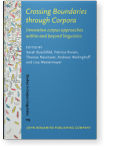Chapter 2
New approaches to investigating change in derivational productivity
Gender and internal factors in the development of ‑ity and ‑ness,
1600–1800
We study the productivity of the suffixes ‑ness and ‑ity in seventeenth‑
and eighteenth-century letters in the Corpora of Early English Correspondence. We analyze the role of
gender and five internal factors: etymology, the word class of the base, branching structure, semantics, and
occurrence in possessive constructions. We develop statistical and visual methods that facilitate diachronic
comparisons within factors and between competing suffixes; our basic measure is the proportion of types of interest
out of all relevant types, and we utilize permutation testing to assess the statistical significance of our findings.
Our results support and refine the earlier finding of a male-led increase in the productivity of ‑ity
and provide new information on the interplay of gender and internal factors.
Article outline
- 1.Introduction
- 2.Background
- 2.1The suffixes ‑ity and ‑ness
- 2.2Measuring variation and change in morphological productivity
- 2.3Productivity change in Construction Grammar
- 3.Material and methods
- 3.1Material: Corpora of Early English Correspondence
- 3.2Methods
- 3.2.1Type-based measures
- 3.2.2External and internal factors
- 3.2.3Token-based measures
- 3.2.4Prior work and key new ideas
- 4.Results
- 4.1Suffix competition
- 4.2Internal factors: Type-based measures
- 4.3Internal factors: Token-based measures
- 5.Discussion and conclusion
-
Acknowledgements
-
Notes
-
References
